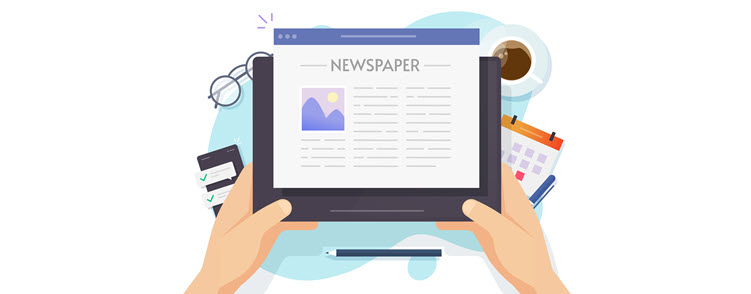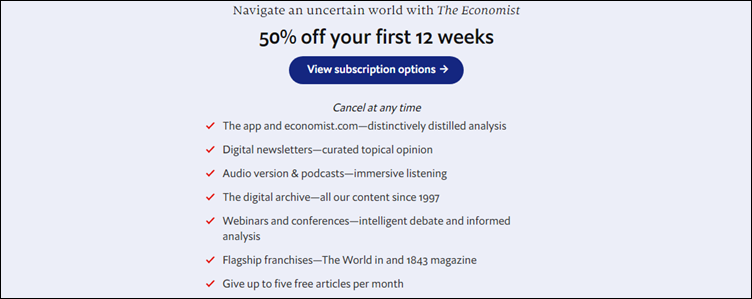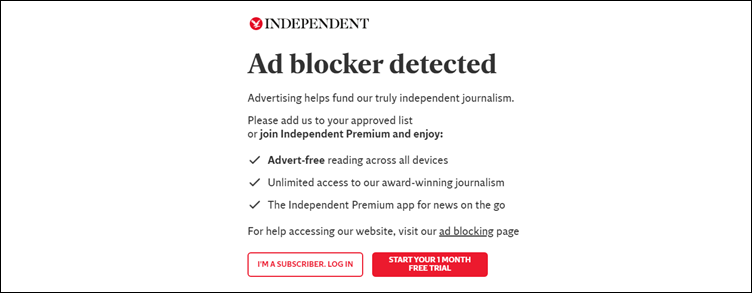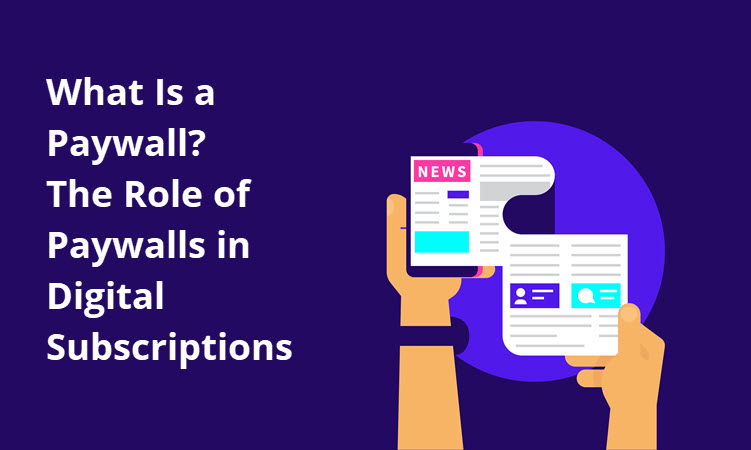Digital subscriptions have become the new normal not only for newspapers and magazines, but also for other online content creators.
Reuters Institute for the Study of Journalism reports that in 2019 about 76% of major US newspapers used paywalls for their digital editions. Some of the most popular daily newspapers and magazines, like The New York Times, The Wall Street Journal, The Chicago Tribune, and others, have embraced a subscription-based model to ensure recurring revenue.
Digital media companies use paywalls to restrict access to content and convince readers to pay for subscriptions. In this article, we’ll explain what a paywall is and how digital publishers use them to boost their revenue.
What Is a Paywall?
A paywall is a strategy for limiting full access to certain digital content by requiring subscription payments.
When a visitor comes to a website that uses a paywall, they can’t see its content until they pay the required subscription. Publishers can restrict all content on a website or only some sections. For example, when a visitor wants to read an article on a paywall-protected website, they may see a small portion of the text before a paywall notification pops up.
Every individual publisher decides how much content they want to hide behind a paywall and what articles they offer for free, if any at all.
Paywall Types and Models

Depending on their goals and traditions, digital media outlets usually opt for one the following paywall models. Each payment type and model brings certain benefits.
Soft or Metered Paywalls
A metered paywall is a method in which all published content within a digital publication is available for reading, but the number of articles is limited.
Publishers using a metered paywall rely on cookies to detect the number of articles a particular reader has read within a month. It’s possible to limit the number of available articles based on the reader’s geographical location, the number of times they have visited the website, or the number of pages they have viewed.
Some publishers only ask their readers to register, while others require a paid subscription to access the restricted content.
The New York Times is a good example of a publisher that uses a metered paywall. When a reader logs in, they can access a limited number of articles. Only if they subscribe to the online edition can they enjoy full-scale access.

Hard Paywalls
A hard paywall hides all content published within a digital publication from non-subscribers.
Readers can’t read a single article until they’ve paid either a monthly or annual subscription.
For instance, The Economist uses a hard paywall. When a reader clicks on an article, they can read only the introduction and then they see the notification below.

A hard paywall is commonly used by exclusive newspapers and magazines whose readers are mainly experts in their fields.
This isn’t the best option for new digital publications and content creators who are still trying to attract regular readers.
Freemium Paywalls
The term freemium is a blend of words “free” and “premium.”
In a freemium paywall, publishers allow readers to access a subset of their content for free. However, they restrict access to premium content or certain features to only subscribers or registered users.
For instance, a publisher might decide to offer older articles for free and protect newer content with a paywall.
The Guardian offers its content for free, but with ads. Readers who pay a subscription get access without ads and can use two additional apps, as shown below.

Dynamic Paywalls
Dynamic paywalls don’t apply the same limits to all readers. They’re based on an individual reader’s habits and personalized data. Publishers can choose how restrictive or flexible their dynamic paywall will be.
For instance, Hearst uses dynamic paywalls for their publications, such as The San Francisco Chronicle, The Houston Chronicle, The Connecticut Post, and many others. When a reader clicks on the subscribe button on any of these websites, there’s a popup window where they can choose their cookie preferences. This publisher may apply different paywalls to different types of readers, based on the data they collect about their reading habits.
A reader who only reads sports news on The Houston Chronicle’s website will get more content for free than a visitor who visits the sites of multiple newspapers owned by Hearst Newspapers.

AdBlock Walls
Some websites make money from ads. Readers that use AdBlock tools reduce publishers’ revenue.
Therefore, some publishers add an AdBlock wall to their websites to prevent readers using AdBlock from accessing their content.
For instance, The Independent uses this method to ask visitors to whitelist their online edition to keep reading the content for free.

If a reader doesn’t switch off the AdBlock tool, they’re not allowed to access any content.
For new publishers or entrepreneurs starting a subscription business, this paywall could result in a high abandonment rate.
Moreover, some publishers kindly ask readers to whitelist their websites but don’t restrict access to their content. This option is usually ineffective because most users just dodge the notification and keep reading.
Server-Side Paywalls
With a server-side paywall, the server hosting the website is programed to show content only to readers who are permitted to see it.
So, the content in question isn’t available in the website code until the server gets a message that the reader is either a registered user or a subscriber. Only then does the server allow for the content to be visible on the website. This paywall is efficient in preventing readers from accessing the paywalled content without paying a subscription.
Client- or Browser-Side Paywalls
In a client- or browser-side paywall, the content is present in the website code and in the browser. When readers visit such a webpage, they might even see the content in question for a few seconds.
After that, they see a notification that tells them they need to either register or subscribe to access the content.
This paywall technique is less secure because readers can circumvent the restriction and access the content for free.
Note: Check out our list of best paywall solutions for publishers.
Paywall Advantages and Disadvantages

Setting a paywall brings benefits to some online businesses, but it can be counterproductive for others.
For online publishers, the main pros and cons of using paywall are:
| Paywall Advantages | Paywall Disadvantages |
|---|---|
| Easily projected recurring revenue | Higher customer churn rate |
| Greater brand appreciation | Potentially complicated to implement |
| Deeper connection with users | Lower income from advertising |
Using Paywalls for Digital Subscriptions
Paywalls are commonly used by newspapers and magazines that use digital subscriptions to make up for revenue losses from print editions.
Paywalls are gaining popularity on other platforms, as well. Many subscription businesses and content creators are starting to use some of the paywalls above to make money online.
For example, some podcast authors upload only part of their shows to YouTube for free as a teaser to attract viewers. They add a link to their Patreon account in the video description. Users that get interested in the teaser pay a subscription via Patreon to get access to the entire video and other exclusive content.
This is only one of the many ways content creators can implement paywalls to charge users for the content they produce.
How to Set Up a Paywall
Large publishers and small content creators may apply different tactics to set up a paywall.
Large businesses that have enough assets can work directly with developers to code a paywall into their website.
They can combine a paywall with tiered pricing models, as well, to provide more options to potential users. For instance, the first tier could include using content for free but with ads. The second tier could give access to most of the content, without ads, for a certain fee. The third tier could open exclusive or premium content, and so on.
Smaller businesses and content creators can use WordPress plugins or subscription management software tools to add paywalls to their websites.
What Is a Paywall Stop Rate?

A paywall stop rate is the percentage of all unique visitors that have faced a subscription paywall after they've reached the limit of available free content in a given month. That’s the point where they either pay a subscription or leave the website.
What Is a Porous or Leaky Paywall?
A leaky or porous paywall lets readers view content that they’re not permitted to view.
Sometimes, publishers intentionally remove restrictions from their premium content, like in the case of local emergency or natural catastrophe.
Some websites using a metered paywall don’t count the first article that a visitor reads from a search engine results.
There are websites whose paywalls don’t recognize visitors using an incognito mode. Others fail to catch readers that regularly delete cookies because they don’t have input data to work with.
A leaky paywall affects business revenue, so publishers need to address this issue.
Is Bypassing Paywalls Illegal?
Bypassing a paywall can be considered a violation of the Digital Millennium Copyright Act. In practice, however, nobody has yet been prosecuted for cheating a metered paywall on a newspaper website.
The worst thing that happens to people who try to circumvent a paywall is that they get blacklisted by the website in question.
Still, readers should follow the rules of terms and agreements if they want to enjoy the full-scale user experience on such websites.
Conclusion
Traditional media forms, like newspapers and magazines, apply paywalls in their digital editions to monetize their work and keep producing relevant content.
New generations of content creators have followed suit and use paywalls, as well.
In the future, we can expect further diversification of digital subscriptions that will help content creators and readers produce and use the content that meets their respective needs.
